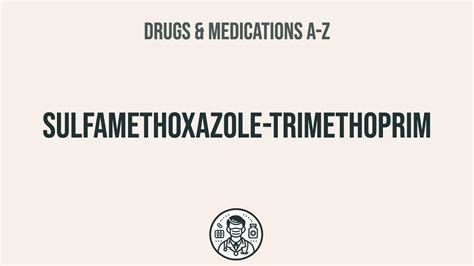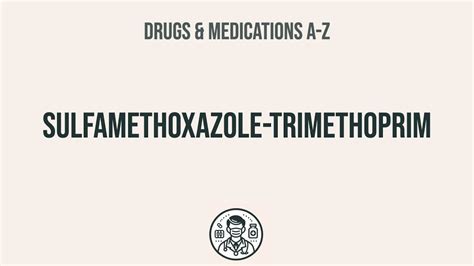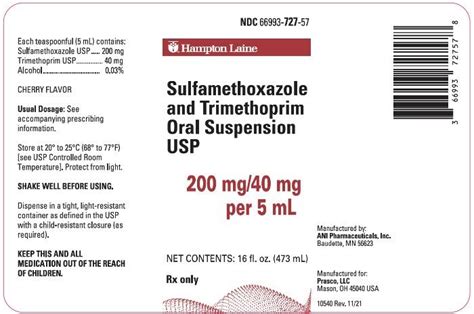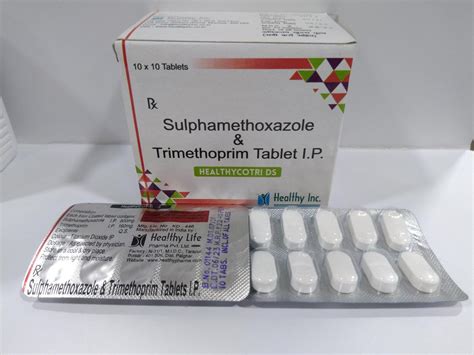Intro
Discover Sulfamethoxazole Tmp side effects, including allergic reactions, gastrointestinal issues, and interactions. Learn about adverse effects, warnings, and precautions for this antibiotic combination.
The importance of understanding the potential side effects of medications cannot be overstated, especially when it comes to antibiotics like sulfamethoxazole/trimethoprim (SMX/TMP), commonly known as Bactrim, Septra, or Cotrim. This combination antibiotic is used to treat a wide range of bacterial infections, including urinary tract infections, bronchitis, and traveler's diarrhea, among others. Its effectiveness in combating bacterial infections has made it a staple in many healthcare settings. However, like all medications, SMX/TMP can cause side effects, some of which can be severe. It's crucial for patients to be aware of these potential side effects to ensure safe and effective treatment.
The mechanism of action of SMX/TMP involves inhibiting the growth and multiplication of bacteria by interfering with the production of folic acid, a nutrient essential for bacterial DNA synthesis. While this action is beneficial in eliminating harmful bacteria, it can also lead to various side effects, ranging from mild to severe. Patients should be informed about the potential risks associated with this medication to make informed decisions about their treatment. Furthermore, understanding the side effects can help healthcare providers monitor patients more effectively and adjust treatment plans as needed.
The use of SMX/TMP is widespread due to its broad-spectrum activity against both Gram-positive and Gram-negative bacteria. However, its side effect profile can sometimes limit its use, especially in certain patient populations such as those with known allergies to sulfonamides or trimethoprim, significant kidney or liver dysfunction, or those taking certain other medications that may interact with SMX/TMP. Despite these limitations, SMX/TMP remains a valuable option in the treatment of bacterial infections, and its benefits often outweigh the risks when used appropriately.
Sulfamethoxazole Tmp Common Side Effects

Less Common Side Effects
Less common but more serious side effects of SMX/TMP include severe allergic reactions, such as Stevens-Johnson syndrome and toxic epidermal necrolysis, which are life-threatening conditions requiring immediate medical attention. Other less common side effects include liver damage, indicated by elevated liver enzymes, and kidney damage, which may manifest as a decrease in urine output or an increase in serum creatinine levels. Monitoring liver and kidney function before and during treatment with SMX/TMP is essential, especially in patients with pre-existing liver or kidney disease.Sulfamethoxazole Tmp Serious Side Effects

Management of Side Effects
The management of side effects associated with SMX/TMP involves a combination of supportive care and, in some cases, discontinuation of the medication. For mild side effects such as nausea and vomiting, patients can try taking the medication with food or using anti-emetic medications. For more severe side effects, such as severe allergic reactions or blood dyscrasias, immediate medical attention is necessary. In some cases, alternative antibiotics may be prescribed to complete the treatment course.Sulfamethoxazole Tmp Interactions

Precautions and Warnings
Precautions and warnings associated with the use of SMX/TMP include the risk of hypersensitivity reactions, especially in patients with a history of allergy to sulfonamides or trimethoprim. Patients with significant kidney or liver dysfunction should use SMX/TMP with caution and under close medical supervision due to the potential for increased toxicity. Additionally, SMX/TMP should be used with caution in pregnant women, particularly during the first trimester, and in breastfeeding mothers, as it can pass into breast milk and potentially harm the infant.Sulfamethoxazole Tmp Dosage

Administration and Storage
SMX/TMP should be administered orally, preferably with a full glass of water, and can be taken with or without food. However, taking it with food may help reduce gastrointestinal side effects. The medication should be stored at room temperature, away from moisture and light, and kept out of reach of children.Sulfamethoxazole Tmp Overdose

Long-term Use
Long-term use of SMX/TMP is generally not recommended due to the potential for increased toxicity and the development of resistance. However, in certain cases, such as the treatment of chronic bronchitis or the prevention of recurrent urinary tract infections, long-term use may be necessary under close medical supervision.Sulfamethoxazole Tmp Alternatives

Conclusion and Future Directions
In conclusion, while SMX/TMP is an effective antibiotic for treating various bacterial infections, its potential side effects and interactions must be carefully considered. Future research should focus on developing new antibiotics with fewer side effects and a lower potential for resistance. Additionally, improving patient education and adherence to treatment regimens can help minimize the risk of side effects and ensure the effective use of SMX/TMP.What is the most common side effect of sulfamethoxazole/trimethoprim?
+Nausea and vomiting are among the most common side effects of sulfamethoxazole/trimethoprim, affecting a significant proportion of patients taking this medication.
Can sulfamethoxazole/trimethoprim be used in pregnant women?
+Sulfamethoxazole/trimethoprim should be used with caution in pregnant women, especially during the first trimester, due to the potential risk of kernicterus in the newborn. However, it may be prescribed if the benefits outweigh the risks.
How long does it take for sulfamethoxazole/trimethoprim to start working?
+The onset of action of sulfamethoxazole/trimethoprim can vary depending on the type of infection being treated but typically starts within a few days of initiating therapy. It's essential to complete the full course of treatment as prescribed to ensure the infection is fully cleared.
As we conclude our discussion on sulfamethoxazole/trimethoprim, it's clear that while this antibiotic is a valuable tool in the treatment of bacterial infections, its use must be approached with caution and a thorough understanding of its potential side effects and interactions. By being informed and working closely with healthcare providers, patients can ensure safe and effective treatment. We invite readers to share their experiences or ask questions about sulfamethoxazole/trimethoprim and its use in treating bacterial infections. Your feedback and engagement are invaluable in helping us provide the most accurate and helpful information possible.
